Samsung PL42C450B1, PL50C450B1 Manual
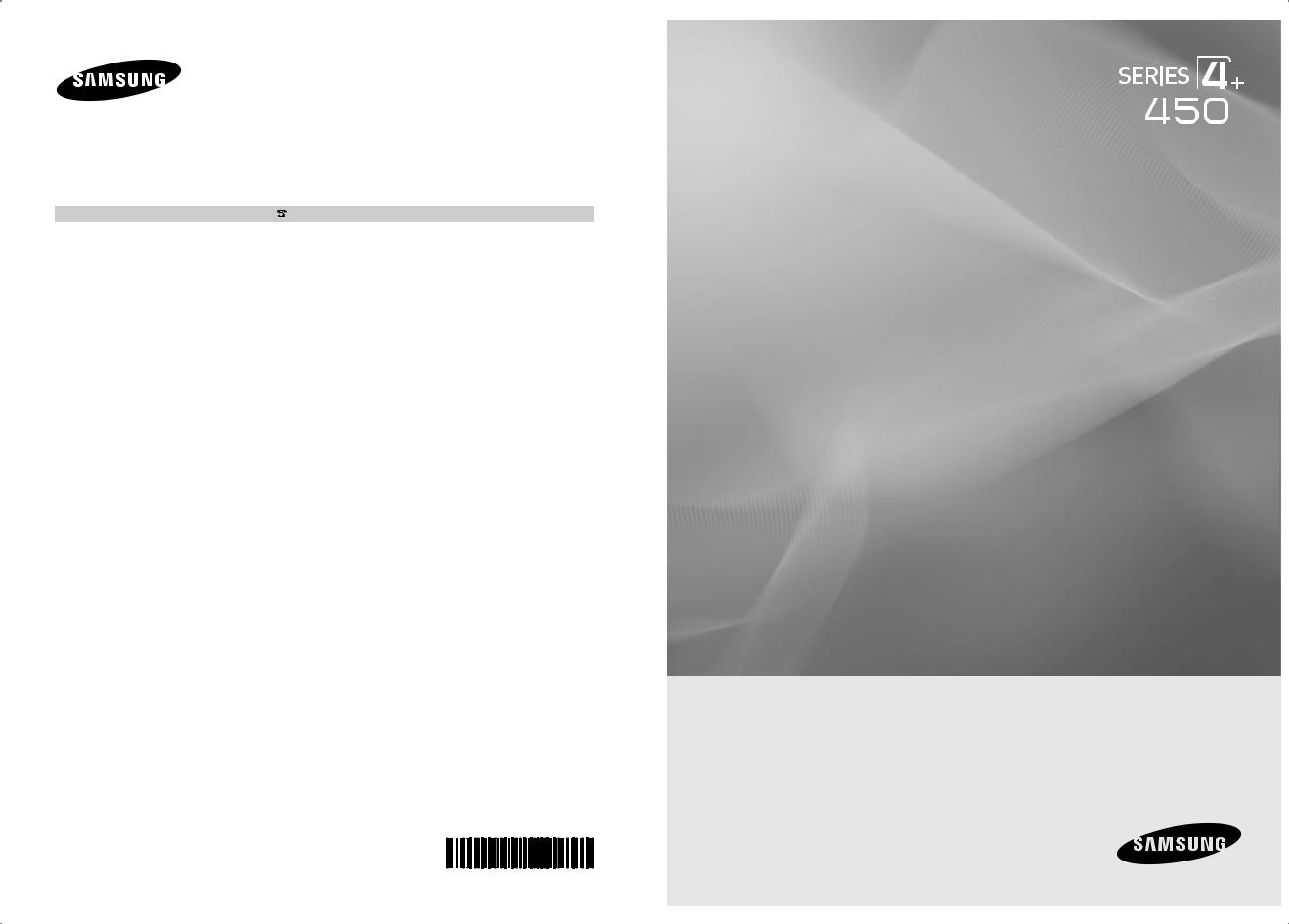
Contact SAMSUNG WORLDWIDE
If you have any questions or comments relating to Samsung products, please contact the SAMSUNG customer care center.
Comuníquese con SAMSUNG WORLD WIDE
Si desea formular alguna pregunta o comentario en relación con los productos de Samsung, comuníquese con el centro de atención al cliente de SAMSUNG.
Country |
Customer Care Center |
Web Site |
ARGENTINE |
0800-333-3733 |
www.samsung.com |
BRAZIL |
0800-124-421 |
www.samsung.com |
|
4004-0000 |
|
CHILE |
800-SAMSUNG(726-7864) |
www.samsung.com |
Nicaragua |
00-1800-5077267 |
www.samsung.com |
Honduras |
800-7919267 |
www.samsung.com |
COSTA RICA |
0-800-507-7267 |
www.samsung.com |
ECUADOR |
1-800-10-7267 |
www.samsung.com |
EL SALVADOR |
800-6225 |
www.samsung.com |
GUATEMALA |
1-800-299-0013 |
www.samsung.com |
JAMAICA |
1-800-234-7267 |
www.samsung.com |
PANAMA |
800-7267 |
www.samsung.com |
PUERTO RICO |
1-800-682-3180 |
www.samsung.com |
REP. DOMINICA |
1-800-751-2676 |
www.samsung.com |
TRINIDAD & TOBAGO |
1-800-SAMSUNG(726-7864) |
www.samsung.com |
VENEZUELA |
0-800-100-5303 |
www.samsung.com |
COLOMBIA |
01-8000112112 |
www.samsung.com |
Plasma TV
user manual
imagine the possibilities
Thank you for purchasing this Samsung product. To receive more complete service, please register your product at
www.samsung.com/register
Model______________ Serial No.______________
© 2010 Samsung Electronics Co., Ltd. All rights reserved. |
BN68-02771A-01 |
|

Figures and illustrations in this User Manual are provided for reference only and may differ from actual product appearance. Product design and specifications may be changed without notice.
User Instructions
•Screen Image retention
Do not display a still image (such as on a video game) on the plasma display panel for more than several minutes as it can cause screen image retention. This image retention is also known as ‘screen burn’. To avoid such image retention, refer to page 13 of this manual to reduce the degree of brightness and contrast of the screen when displaying a still image.
•Heat on the top of the Plasma TV
The top side of the product may be hot after long periods of use as heat dissipates from the panel through the vent hole in the upper part of the product.
This is normal and does not indicate any defect or operation failure of the product. However, children should be prevented from touching the upper part of the product.
•The product is making a ‘cracking’ noise.
A ‘cracking’ noise may occur when the product contracts or expands due to a change in the surrounding environment such as temperature or humidity. This is normal and not a defect of the unit.
•Cell Defects
The PDP uses a panel consisting of 2,360,000(HD-level) to 6,221,000(FHD-level) pixels which require sophisticated technology to produce. However, there may be a few bright or dark pixels on the screen. These pixels will have no impact on the performance of the product.
•Avoid operating the TV at temperatures below 41°F (5°C)
•A still image displayed too long may cause permanent damage to the PDP Panel.
 Watching the Plasma TV in 4:3 format for a long period of time may leave traces of borders displayed on the left, right and center of the screen caused by the difference of light emission on the screen. Playing a DVD or a game console may cause similar effects to the screen.
Watching the Plasma TV in 4:3 format for a long period of time may leave traces of borders displayed on the left, right and center of the screen caused by the difference of light emission on the screen. Playing a DVD or a game console may cause similar effects to the screen.
 Damages caused by the above effect are not covered by the Warranty.
Damages caused by the above effect are not covered by the Warranty.
•After-images on the Screen.
Displaying still images from Video games and PC for longer than a certain period of time may produce partial after-images. To prevent this effect, reduce the ‘brightness’ and ‘contrast’ when displaying still images for a long time.
•Warranty
Warranty does not cover any damage caused by image retention. Burn-in is not covered by the warranty.
2English

Contents |
|
|
Getting Started |
|
|
yy |
List of Features.......................................................... |
4 |
yy |
Accessories............................................................... |
4 |
yy Viewing the Control Panel.......................................... |
5 |
|
yy Viewing the Remote Control ..................................... |
6 |
|
yy Connecting to an Antenna......................................... |
7 |
|
yy Plug & Play (Initial Setup)........................................... |
7 |
|
Connections |
|
|
yy Connecting to an AV Device...................................... |
8 |
|
yy Connecting to an Audio Device.................................. |
9 |
|
yy Connecting to a PC................................................... |
9 |
|
yy Changing the Input Source...................................... |
10 |
|
Basic Features |
|
|
yy How to Navigate Menus.......................................... |
11 |
|
yy |
Channel Menu......................................................... |
11 |
|
Seeing Channels |
11 |
|
Using Favorite Channels |
12 |
|
Memorizing Channels |
12 |
|
Editing Channels |
12 |
|
Other Features |
12 |
yy |
Picture Menu........................................................... |
13 |
|
Changing the Preset Picture Mode |
13 |
|
Adjusting Picture Settings |
13 |
|
Economical Solutions |
14 |
|
Changing the Picture Options |
14 |
|
Setting up the TV with Your PC |
16 |
yy |
Sound Menu............................................................ |
16 |
|
Changing the Preset Sound Mode |
16 |
|
Adjusting Sound Settings |
16 |
|
Sound Settings |
16 |
yy |
Setup Menu............................................................. |
17 |
|
Setting the Time |
17 |
|
Using the Sleep Timer |
18 |
|
Setting the On / Off Timer |
18 |
|
Other Features |
18 |
|
Picture In Picture (PIP) |
19 |
yy |
Support Menu......................................................... |
20 |
Advanced Features |
|
|
yy |
Media Play............................................................... |
21 |
|
Connecting a USB Device |
21 |
|
Screen Display |
22 |
|
Playing Multiple Files |
25 |
|
Media Play - Additional Functions |
26 |
yy |
Anynet+................................................................... |
27 |
|
Setting Up Anynet+ |
28 |
|
Switching between Anynet+ Devices |
28 |
|
Recording |
29 |
|
Listening through a Receiver |
29 |
|
Troubleshooting for Anynet+ |
30 |
Other Information |
|
|
yy |
FM Transmitter Setup.............................................. |
31 |
|
Frequency Configuration |
31 |
|
FM Transmitter Installation Guide |
31 |
|
Supported FM Transmitter formats |
32 |
yy Installing the Wall Mount.......................................... |
32 |
|
yy Securing the Installation Space................................ |
33 |
|
yy Securing the TV to the wall...................................... |
34 |
|
|
To Avoid the TV from Falling |
34 |
yy |
Troubleshooting....................................................... |
35 |
yy |
Specifications.......................................................... |
38 |
yy |
License.................................................................... |
38 |
yy |
Index....................................................................... |
39 |
ENGLISH
Check the Symbol!
t
|
Note |
Step by Step Guide |
This function can be used by pressing the |
Indicates additional information. |
Check here for instructions on how to open |
TOOLS button on the remote control. |
|
the relevant submenu within the OSD y |
|
|
(on screen display). |
English 3
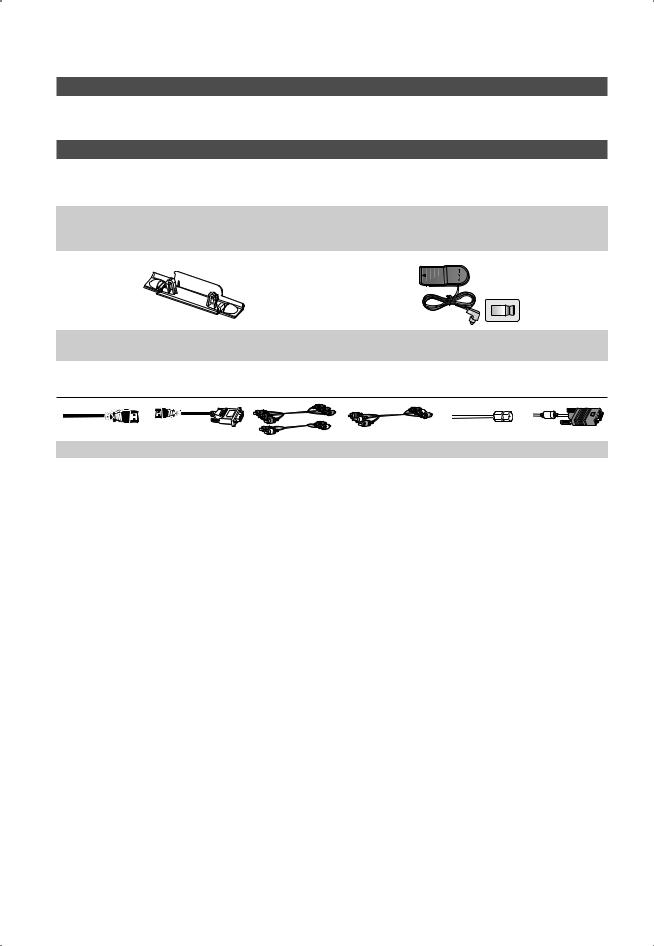
Getting Started
List of Features
yy Media Play (USB): Allows you to play some music files, pictures saved on a USB device. (p. 21) yy Self Diagnosis: You can check to make sure picture and sound operate normally (p. 20)
Accessories
Please make sure the following items are included with your PDP TV. If any items are missing, contact your dealer.The items’ colors and shapes may vary depending on the models.
yy Remote Control & Batteries (AAA x 2) (Not available in some locations) |
yy |
Cleaning Cloth |
|
yy |
Owner’s Instructions |
yy |
Power Cord |
yy |
Warranty Card / Safety Guide (Not available in some locations) |
|
|
yy Blanking Bracket |
yy FM Transmitter / FM Transmitter Clamp (3EA) |
|
(Not available in some locations) |
Input Cables (Sold Separately)
HDMI |
HDMI-DVI |
Component |
Composite (AV) |
Coaxial (RF) |
VGA |
|
|
|
|
|
|
4English
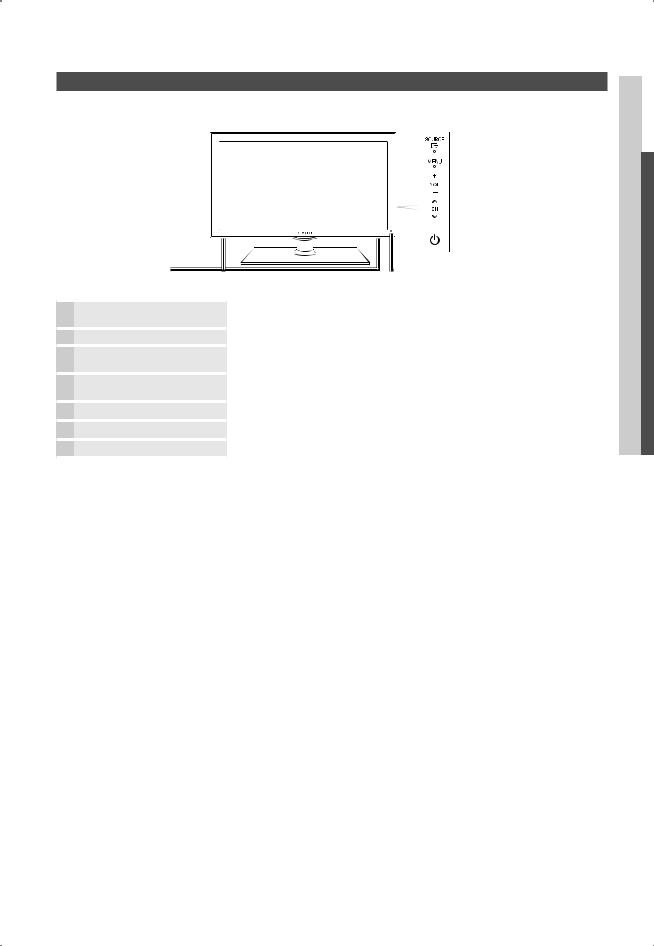
Viewing the Control Panel
The product color and shape may vary depending on the model.
Speakers
SOURCEE

 Power Indicator
Power Indicator
 Remote control sensor
Remote control sensor
Toggles between all the available input sources. In the on-screen menu, use this button as you would use the ENTERE button on the remote control.
MENU |
Displays an on-screen menu, the OSD (on screen display) of your TV’s features. |
y |
Adjusts the volume. In the OSD, use the y buttons as you would use the |
|
◄ and ► buttons on the remote control. |
z |
Changes the channels. In the OSD, use the z buttons as you would use the |
|
▼ and ▲ buttons on the remote control. |
Power Indicator |
Blinks and turns off when the power is on and lights up in standby mode. |
P (Power) |
Turns the TV on or off. |
Remote control sensor |
Aim the remote control towards this spot on the TV. |
Standby mode
Do not leave your TV in standby mode for long periods of time (when you are away on a holiday, for example). A small amount of electric power is still consumed even when the power button is turned off. It is best to unplug the power cord.
 Started Getting 01
Started Getting 01
English 5
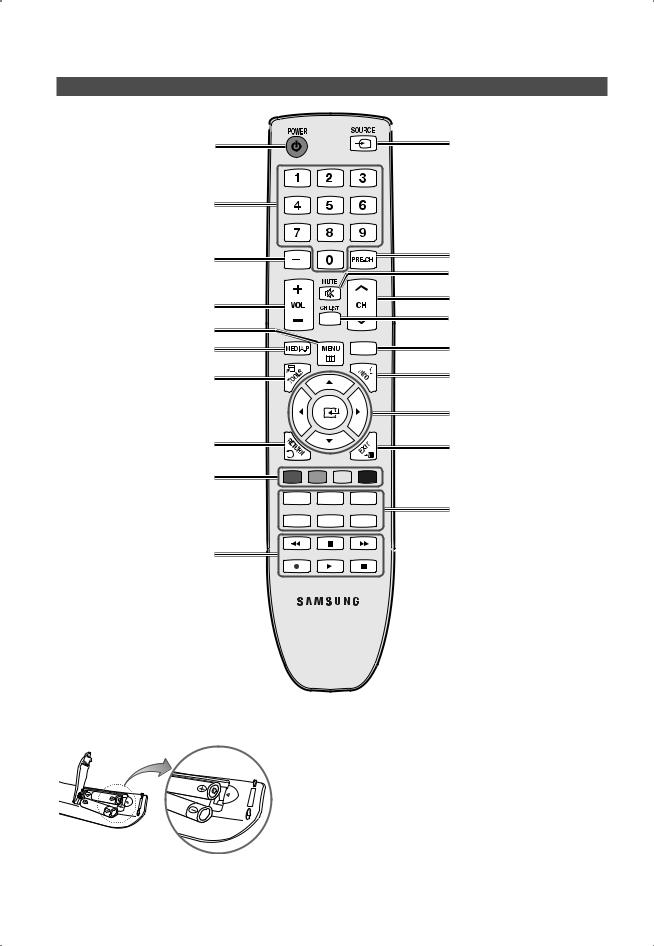
Getting Started
Viewing the Remote Control
Turns the TV on and off.
Press to directly access channels.
Not Available.
Adjusts the volume.
Brings up the OSD. Displays Media Play (USB) (p. 21).
Quickly select frequently used functions.
Returns to the previous menu.
These buttons are for the Channel List, Media Play (USB) menu, etc.
Displays and selects the available video sources (p. 10).
|
Returns to the previous channel. |
|
Cuts off the sound temporarily. |
|
Changes channels. |
|
Displays the channel list on the screen |
|
(p. 11). |
HDMI |
Selects the HDMI mode directly. |
|
Displays information on the TV screen. |
|
Selects the on-screen menu items and |
|
changes the values seen on the menu. |
|
Exits the menu. |
A B C D
S.MODE P.MODE MTS
Use these buttons in Media Play (USB) and Anynet+ (HDMI-CEC) modes (p. 21, 27).
( : Controls recording for Samsung recorders that have the Anynet+ feature)
Installing batteries (Battery size: AAA)
6English
|
|
S.MODE: Press to select the sound |
FAV.CH P.SIZE |
SLEEP |
mode (p. 16). |
|
|
P.MODE: Press to select the picture |
|
|
mode (p. 13). |
|
|
MTS: Press to choose stereo, mono |
|
|
or Separate Audio Program (SAP |
|
|
broadcast) (p. 17). |
|
|
FAV.CH: Displays Favorite Channel Lists |
|
|
on the screen (p. 12). |
|
|
P.SIZE: Selects the picture size |
|
|
(p. 15). |
|
|
SLEEP: Automatically shuts off the TV at |
|
|
a preset time (p. 18). |
NOTE
xx Use the remote control within 23 feet from the TV.
xx Bright light may affect the performance of the remote control. Avoid use when nearby fluorescent lights or neon signs.
xx The color and shape may vary depending on the model.
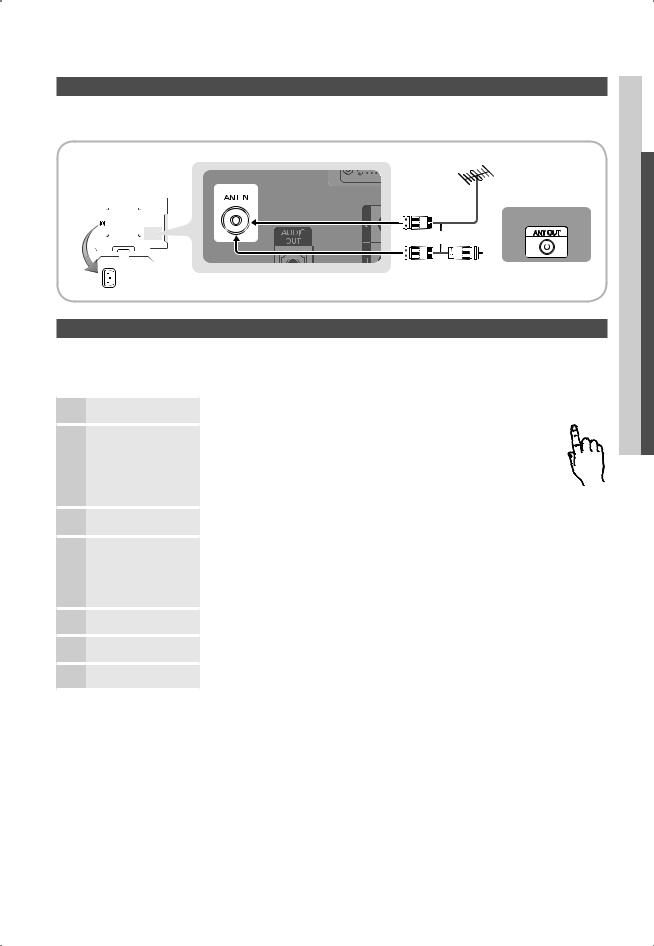
Connecting to an Antenna
When the TV is initially powered on, basic settings proceed automatically.Connecting the power cord and antenna.
VHF/UHF Antenna
Cable
or |
ANT OUT |
|
Power Input
Plug & Play (Initial Setup)
When the TV is initially powered on, a sequence of on-screen prompts will assist in configuring basic settings. Press the POWERP button. Plug & Play is available only when the Input source is set to TV.
To return to the previous step, press the Red button.
1 |
Selecting a language |
2 |
Selecting Store Demo |
or Home Use |
|
3 |
Selecting an antenna |
4 |
Selecting a channel |
5 |
Setting the Clock |
6 |
Viewing the |
HD Connection Guide. |
|
7 |
Enjoy your TV. |
Press the ▲ or ▼ button, then press the ENTERE button. Select the |
POWER |
desired OSD (On Screen Display) language. |
P |
|
|
Press the ◄ or ► button, then press the ENTERE button. |
|
yy Select the Home Use mode. Store Demo Mode is for retail environments.
yy To return the unit’s settings from Store Demo to Home Use (standard): Press the volume button on the TV. When you see the volume OSD, press and hold MENU for 5 sec.
Press the ▲ or ▼ button, then press the ENTERE button. Select Air, Cable or
Air+Cable.
Press the ▲ or ▼ button, then press the ENTERE button. Select the channel source to memorize. When setting the antenna source to Cable, a step appears allowing you to
assign numerical values (channel frequencies) to the channels. For more information, refer to
Channel → Auto Program (p.12).
Press the ENTERE button at any time to interrupt the memorization process. Set the Day, Month, Year, Hour, Minute, or am/pm.
The connection method for the best HD screen quality is displayed.
Press the ENTERE button.
If You Want to Reset This Feature . . .
OO MENUm → Setup → Plug & Play → ENTERE
 Started Getting 01
Started Getting 01
English 7
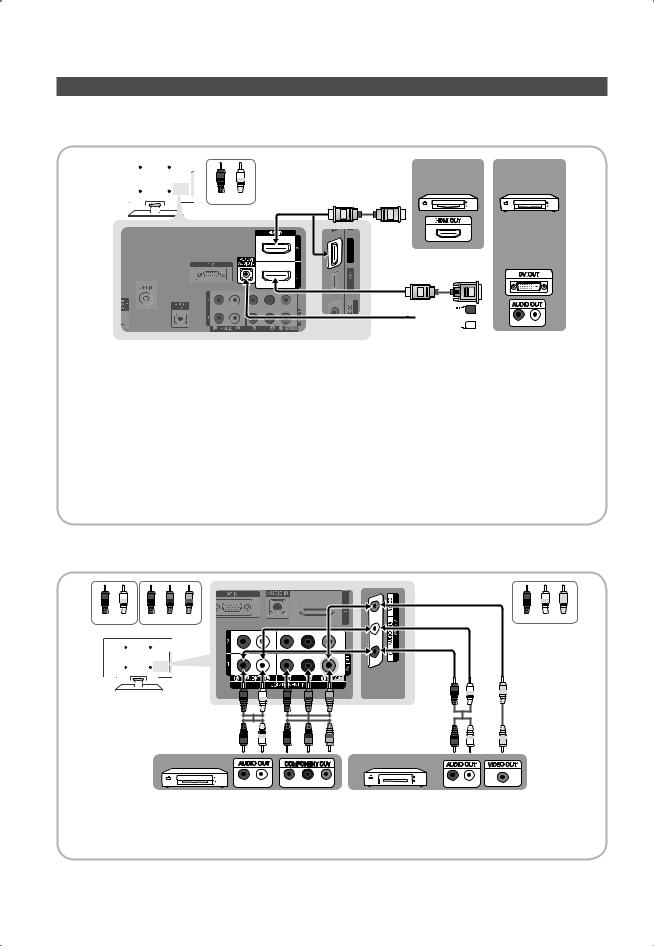
Connections
Connecting to an AV Device
Using an HDMI or HDMI/DVI cable: HD connection (up to 720p/1080i)
Available devices: DVD, Blu-ray player, HD cable box, HD STB (Set-Top-Box) satellite receiver.
R W
Red White
Device Device
(DVI)
HDMI


 OUT
OUT
USB HDMI IN 3
















 W R
W R
DVI
 OUT
OUT
AUDIO OUT
R-AUDIO-L
HDMI IN 1(DVI), 2, 3, PC/DVI AUDIO IN
xx When using an HDMI/DVI cable connection, you must use the HDMI IN 1(DVI) jack for video. A DVD, Blue-ray player, HD cable box, HD STB satellite receiver may require a DVI-HDMI (DVI to HDMI) cable or DVI-HDMI (DVI to HDMI) adapter. The PC/DVI AUDIO IN jack is required for audio.
xx If an external device such as a DVD, Blu-ray player, cable box, STB satellite receiver supporting HDMI versions older than 1.3 is connected, the TV may operate abnormally (e.g. no screen display / no sound / annoying flicker / abnormal color).
xx If there is no sound after connecting an HDMI cable, check the HDMI version of the external device. If you suspect the version is older than 1.3, contact the provider of the device to confirm the HDMI version and request an upgrade.
xx It is recomended you purchase an HDMI-certified cable. Otherwise, the screen may appear blank or a connection error may occur.
Using a Component (up to 720p/1080i) or Audio/Video (480i only) Cable
Available devices: DVD, Blu-ray player, cable box, STB satellite receiver, VCR
R |
W |
R |
B |
G |
R |
W |
Y |
(DVI) |
Red White |
Red Blue Green |
Red White Yellow |
|
|
|
|
R |
W |
Y |
R |
W |
R |
B |
G |
|
|
R W R B G
R W
Y
Device
AUDIO OUT |
COMPONENT OUT |
Device
AUDIO OUT VIDEO OUT
R-AUDIO-L |
PR |
PB |
Y |
R-AUDIO-L |
When connecting to AV IN 1, the color of the AV IN 1 [Y/VIDEO] jack (green) will not match the video cable (yellow).
To obtain the best picture quality, the Component connection is recommended over the A/V connection.
8English
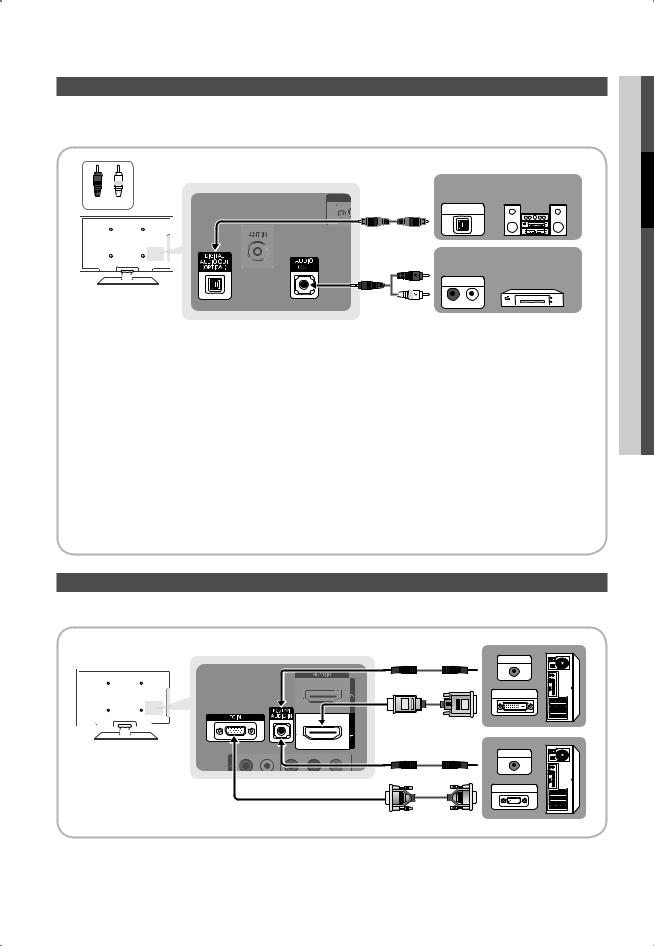
Connecting to an Audio Device
Using an Optical (Digital) or Audio (Analog) Cable Connection
Available devices: Digital Audio System, Amplifier, DVD home theater
R W
Digital Audio System
Red White
OPTICAL
Amplifier / DVD home theater
AUDIO IN
R-AUDIO-L
DIGITAL AUDIO OUT (OPTICAL)
xx When a digital audio system is connected to the DIGITAL AUDIO OUT (OPTICAL) jack, decrease the volume of both the TV and the system.
xx 5.1 CH (channel) audio is available when the TV is connected to an external device supporting 5.1 CH.
xx When the receiver (amplifier or DVD home theater) is set to on, you can hear sound output from the TV’s optical jack. When the TV is receiving a DTV signal, the TV will send 5.1 CH sound to the amplifier or DVD home theater. When the source is a digital component such as a DVD / Blu-ray player / cable box / STB (Set-Top-Box) satellite receiver and is connected to the TV via HDMI, only 2CH audio will be heard from the amplifier or DVD home theater. If you want to hear 5.1 CH audio, connect the digital audio out jack from your DVD / Blu-ray player / cable box / STB satellite receiver directly to an amplifier or home theater.
AUDIO OUT: Connects to the audio input jacks on your Amplifier/Home theater. xx When connecting, use the appropriate connector.
xx When an audio amplifier is connected to the AUDIO OUT jacks: Decrease the volume of the TV and adjust the volume level with the Amplifier’s volume control.
Connecting to a PC
Using an HDMI/DVI Cable or a D-sub Cable
AUDIO OUT
DVI OUT
(DVI)
AUDIO OUT
PC OUT
Connections 02
English 9

Connections
Display Modes (D-Sub and HDMI/DVI Input)
Optimal resolution
yy 42": 1024 X 768 @ 60Hz
yy 50": 1360 X 768 @ 60Hz
|
|
Horizontal |
Vertical |
Pixel Clock |
Sync Polarity |
|
|
|
Mode |
Resolution |
Frequency |
Frequency |
Frequency |
42" |
50" |
||
(H / V) |
||||||||
|
|
(KHz) |
(Hz) |
(MHz) |
|
|
||
|
|
|
|
|
||||
|
|
|
|
|
|
|
|
|
IBM |
640 x 350 |
31.469 |
70.086 |
25.175 |
+/- |
> |
> |
|
720 x 400 |
31.469 |
70.087 |
28.322 |
-/+ |
> |
> |
||
|
||||||||
MAC |
640 x 480 |
35.000 |
66.667 |
30.240 |
-/- |
> |
> |
|
832 x 624 |
49.726 |
74.551 |
57.284 |
-/- |
> |
> |
||
|
||||||||
VESA CVT |
720 x 576 |
35.910 |
59.950 |
32.750 |
-/+ |
> |
> |
|
1280 x 720 |
56.456 |
74.777 |
95.750 |
-/+ |
|
> |
||
|
|
|||||||
|
640 x 480 |
31.469 |
59.940 |
25.175 |
-/- |
> |
> |
|
|
640 x 480 |
37.500 |
75.000 |
31.500 |
-/- |
> |
> |
|
|
640 x 480 |
37.861 |
72.809 |
31.500 |
-/- |
> |
> |
|
|
800 x 600 |
37.879 |
60.317 |
40.000 |
+/+ |
> |
> |
|
|
800 x 600 |
46.875 |
75.000 |
49.500 |
+/+ |
> |
> |
|
VESA DMT |
800 x 600 |
48.077 |
72.188 |
50.000 |
+/+ |
> |
> |
|
|
1024 x 768 |
48.363 |
60.004 |
65.000 |
-/- |
> |
> |
|
|
1024 x 768 |
56.476 |
70.069 |
75.000 |
-/- |
> |
> |
|
|
1024 x 768 |
60.023 |
75.029 |
78.750 |
+/+ |
> |
> |
|
|
1280 x 720 |
45.000 |
60.000 |
74.250 |
+/+ |
|
> |
|
|
1360 x 768 |
47.712 |
60.015 |
85.500 |
+/+ |
|
> |
|
VESA GTF |
1280 x 720 |
52.500 |
70.000 |
89.040 |
-/+ |
|
> |
NOTE
xx For HDMI/DVI cable connection, you must use the HDMI IN 1(DVI) jack. xx The interlace mode is not supported.
xx The set might operate abnormally if a non-standard video format is selected.
xx Separate and Composite modes are supported. SOG(Sync On Green) is not supported.
Changing the Input Source
Source List
Use to select TV or an external input sources |
SOURCE |
such as a DVD / Blu-ray player / cable box / |
|
STB satellite receiver. |
|
OO MENUm → Input → Source List →
ENTERE
■■ TV / PC / AV1 / AV2 / Component1 / Component2 / HDMI1/DVI / HDMI2 / HDMI3 / USB
You can only choose external devices that are connected to the TV. In the Source List, connected inputs will be highlighted.
In the Source List, PC is always activated.
Edit Name
OO MENUm → Input → Edit Name → ENTERE
■■ VCR / DVD / Cable STB / Satellite STB / PVR STB / AV Receiver / Game / Camcorder / PC / DVI PC / DVI Devices / TV / IPTV / Blu-ray / HD DVD / DMA: Name the device connected to the input jacks to make your input source selection easier.
When connecting an HDMI/DVI cable to the
HDMI IN 1(DVI) port, you should set the TV to DVI PC or DVI Devices mode under Edit Name.
10 English
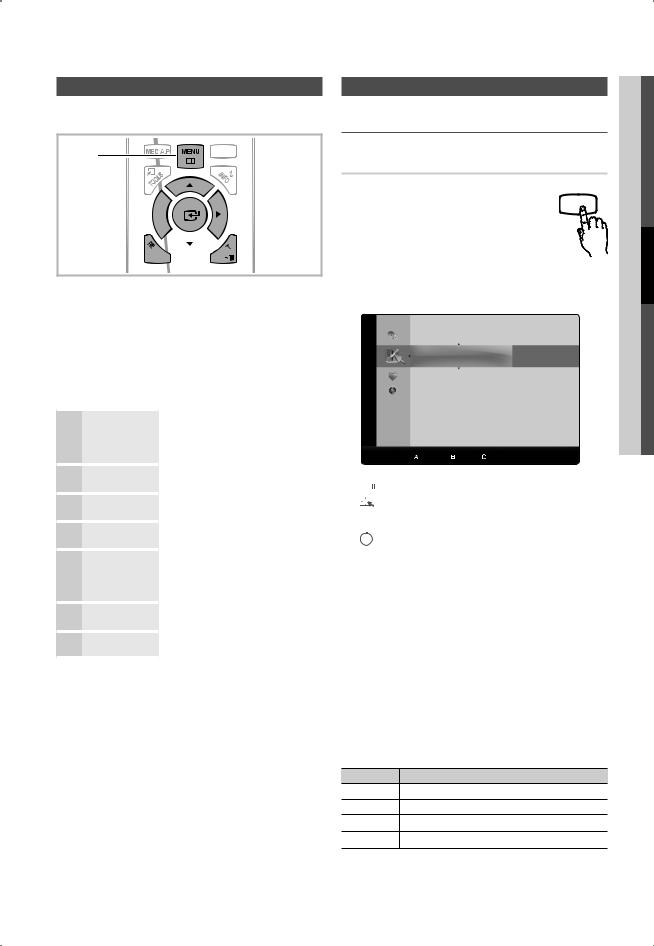
Basic Features
How to Navigate Menus
Before using the TV, follow the steps below to learn how to navigate the menu and select and adjust different functions.
1 |
|
|
|
HDMI |
|
|
|
|
|
|
|
|
|
|
2

3




 4
4
1 MENU button: Displays the main on-screen menu.
2ENTERE / Direction button: Move the cursor and select an item. Confirm the setting.
3 RETURN button: Returns to the previous menu.
4 EXIT button: Exits the on-screen menu.
How to Operate the OSD (On Screen Display)
The access step may differ depending on the selected menu.
1 |
MENUm |
2 |
▲ / ▼ |
3 |
ENTERE |
4 |
▲ / ▼ |
5 |
◄ / ► |
6 |
ENTERE |
7 |
EXITe |
The main menu options appear on the screen:
Picture, Sound, Channel, Setup, Input, Application, Support.
Select an icon with the ▲ or ▼ button.
Press ENTERE to access the sub-menu.
Select the desired submenu with the ▲ or ▼ button.
Adjust the value of an item with the ◄ or ► button. The adjustment in the OSD may differ depending on the selected menu.
Press ENTERE to confirm the selection.
Press EXIT.
Channel Menu
¦¦ Seeing Channels
Channel List
Add, delete or set favorite channels and use the CH LIST program guide for digital broadcasts.
OO MENUm → Channel → Channel List → ENTERE
Select a channel in the All Channels, Added Channels, Favorite or Programmed
screen by pressing the ▲ / ▼ and ENTERE buttons. Then you can watch the selected channel.
Added |
3 |
|
Air |
|
||
4 |
|
Air |
|
|||
Channels |
5 |
* Air |
|
|||
8 |
|
Air |
|
|||
|
6 |
|
Air |
|
||
|
7 |
|
Air |
|
||
|
9 |
|
Air |
|
||
|
10 |
|
Air |
|
||
Air |
|
Antenna |
|
Zoom |
|
Select kPage T Tools |
|
|
|
||||
■■  All Channels: Shows all currently available channels. ■■
All Channels: Shows all currently available channels. ■■  Added Channels: Shows all added channels.
Added Channels: Shows all added channels.
■■ *Favorite: Shows all favorite channels.
■■  Programmed: Shows all currently reserved programs.
Programmed: Shows all currently reserved programs.
Using the color buttons with the Channel List xx  Red (Antenna): Switches to Air or Cable.
Red (Antenna): Switches to Air or Cable.
xx  Green (Zoom): Enlarges or shrinks a channel number.
Green (Zoom): Enlarges or shrinks a channel number.
xx  Yellow (Select): Selects multiple channel lists. Select desired channels and press the Yellow button to set all the selected channels at the same time. The c mark appears to the left of the selected channels.
Yellow (Select): Selects multiple channel lists. Select desired channels and press the Yellow button to set all the selected channels at the same time. The c mark appears to the left of the selected channels.
xx k (Page): Move to next or previous page.
xx T (Tools): Displays the Channel List option menu. (The options menus may differ depending on the situation.)
Channel Status Display Icons
Icons Operations
cA channel selected.
* A channel set as a Favorite.
) A reserved Program.
\A locked channel.
English 11
Features Basic 03
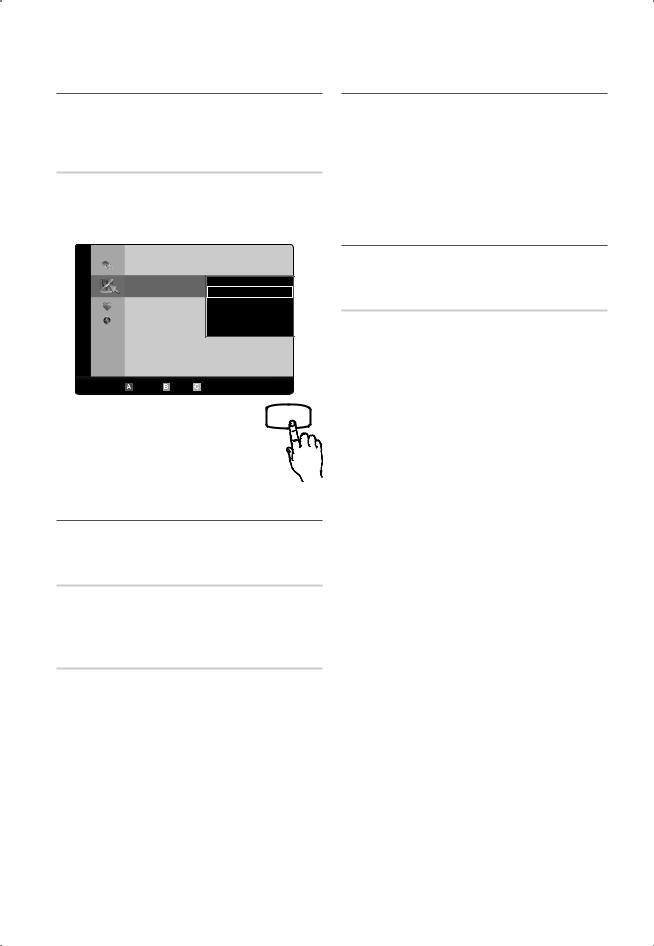
Basic Features
¦¦ Using Favorite Channels
OO MENUm → Channel → Channel List → ENTERE
Add to Favorite / Delete from Favorite t
Set channels you watch frequently as Favorites.
1.Select a channel and press the TOOLS button.
2.Add or delete the channel using the Add to Favorite or
Delete from Favorite menu respectively.
Added |
3 |
Air |
|
|
4 |
Air |
Delete |
|
|
|
|
|||
|
Add to Favorite |
|
||
Channels |
5 |
* Air |
Lock |
|
Timer Viewing |
|
|||
8 |
Air |
|
||
|
6 |
Air |
Channel Name Edit |
|
|
7 |
Air |
SelectAll |
|
|
|
|
|
|
|
9 |
Air |
|
|
|
10 |
Air |
|
|
Air |
Antenna |
Zoom |
Select kPage |
T Tools |
To show all Favorite channels, click on |
FAV.CH |
|||
the button shown on the rignt. |
||||
¦¦ Memorizing Channels
OO MENUm → Channel → ENTERE
Antenna (Air / Cable) t
Before your television can begin memorizing the available channels, you must specify the type of signal source that is connected to the TV (i.e. an Air or a Cable system).
Auto Program
■■ Air: Air antenna signal.
■■ Cable: Cable antenna signal.
■■ Air+Cable: Air and Cable antenna signals.
If you want to stop Auto Programming, press the
ENTERE button. The Stop Auto Program? message will be displayed. Select Yes by pressing the ◄ or ► button, then press the ENTERE button.
¦¦ Editing Channels
OO MENUm → Channel → Channel List → ENTERE
Channel Name Edit
1.Select a channel and press the TOOLS button.
2.Edit the channel name using the Channel Name Edit menu.
■■ Channel Name Edit: Assign your own channel name.
¦¦ Other Features
OO MENUm → Channel → ENTERE
Channel List
Channel List Option Menu
Set each channel using the Channel List menu options (Add / Delete, Lock / Unlock, Timer Viewing, Select All / Deselect All). Option menu items may differ depending on the channel status.
1.Select a channel and press the TOOLS button.
2.Select a function and change its settings.
■■ Add / Delete: Delete or add a channel to display the channels you want.
NOTE
xx All deleted channels will be shown on the
All Channels menu.
xx A gray-colored channel indicates the channel has been deleted.
xx The Add menu only appears for deleted channels.
xx Delete a channel from the Added Channels or Favorite menu in the same manner.
■■ Lock / Unlock: You can lock a channel so that the channel cannot be selected and viewed.
This function is available only when the
Child Lock is set to On.
The PIN input screen appears. Enter your 4-digit PIN, the default of which is “0-0-0-0”. Change the PIN using the Change PIN option.
■■ Timer Viewing: You can set a desired channel to be displayed automatically at the reserved time. Set the current time first to use this function.
1.Press the ◄ / ► / ▲ / ▼ buttons to select the desired channel in Channel List.
2.Press the TOOLS button, then select
Timer Viewing.
12 English
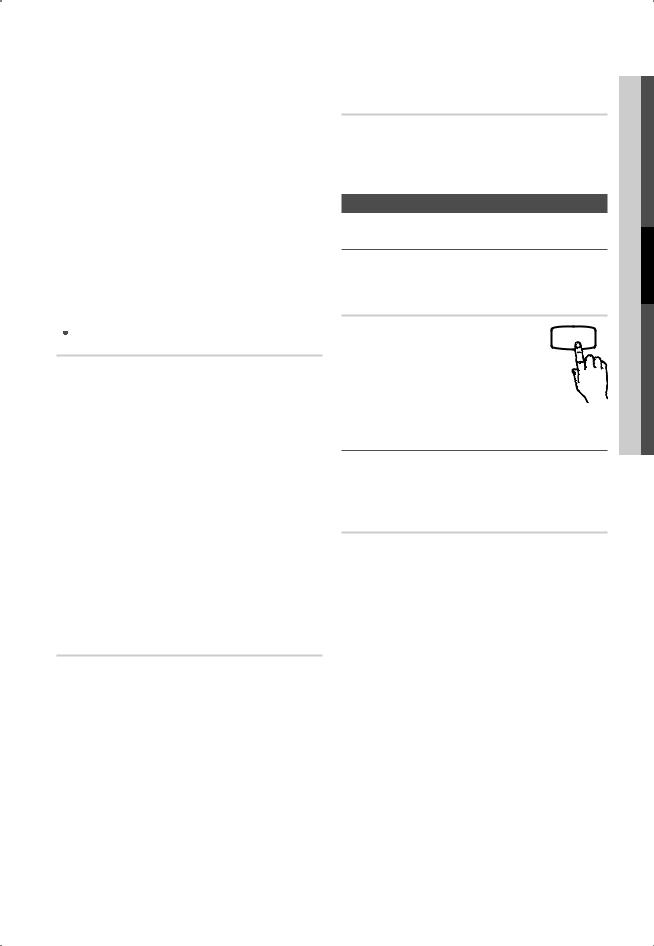
3.Scroll up or down to adjust the settings in the box, or use the numeric buttons on your remote to enter the date and time.
If you selected Once, Every Week or
Every Day in Repeat, you can enter the date you want.
4.Select OK, then press the ENTERE button when done.
NOTE
xx Only memorized channels can be reserved.
xx Reserved programs will be displayed in the
Programmed menu.
■■ Select All: Select all the channels in the Channel List. ■■ Deselect All: Deselect all the selected channels.
You can only select Deselect All when one or more channels are selected.
 Programmed
Programmed
(in Channel List)
You can view, modify or delete a show that you have reserved to watch. Programmed timer viewing is displayed here. Highlight a program and press the TOOLS button to display Options.
■■ Change Info: Change a show you have reserved to watch. Begin with step 3 of “Timer Viewing,” above.
■■ Cancel Schedules: Cancel a show you have reserved to watch.
This deletes the highlighted or selected program(s).
■■ Information: Display a show you have reserved to watch. (You can also change the reservation
Information.) Alternatively, you can view Information by highlighting a program and pressing the ENTERE button.
■■ Select All / Deselect All: Select or deselect all reserved programs.
Fine Tune
If the reception is clear, you do not have to fine tune the channel, as this is done automatically during the search and store operation. If the signal is weak or distorted, fine tune the channel manually. Scroll to the left or right until the image
is clear.
Settings are applied to the channel you're currently watching.
Fine tuned channels that have been saved are marked with an asterisk “*” on the right-hand side of the channel number in the channel banner.
To reset the fine-tuning, select Reset.
Color System (Auto / PAL-M / PAL-N /
NTSC)
Normally the TV can receive image and sound with good quality when in the mode auto. This mode detects the signal color system automatically. In case of some signal reception with color unsatisfactory, select the Color System Mode to
PAL-M, PAL-N or NTSC.
Picture Menu
¦¦ Changing the Preset Picture Mode
OO MENUm → Picture → Mode → ENTERE
Mode |
|
|
Select your preferred picture type. |
P.MODE |
|
■■ Dynamic: Suitable for a bright room. |
||
|
■■ Standard: Suitable for a normal environment.
■■ Movie: Suitable for watching movies in a dark room.
¦¦ Adjusting Picture Settings
OO MENUm → Picture → ENTERE
Cell Light / Contrast / Brightness / Sharpness / Color / Tint (G/R)
Your television has several setting options for picture quality control.
NOTE
xx When you make changes to Cell Light, Contrast, Brightness, Sharpness, Color or Tint (G/R) the OSD will be adjusted accordingly.
xx In PC mode, you can only make changes to
Cell Light, Contrast and Brightness.
xx Settings can be adjusted and stored for each external device connected to the TV.
English 13
Features Basic 03
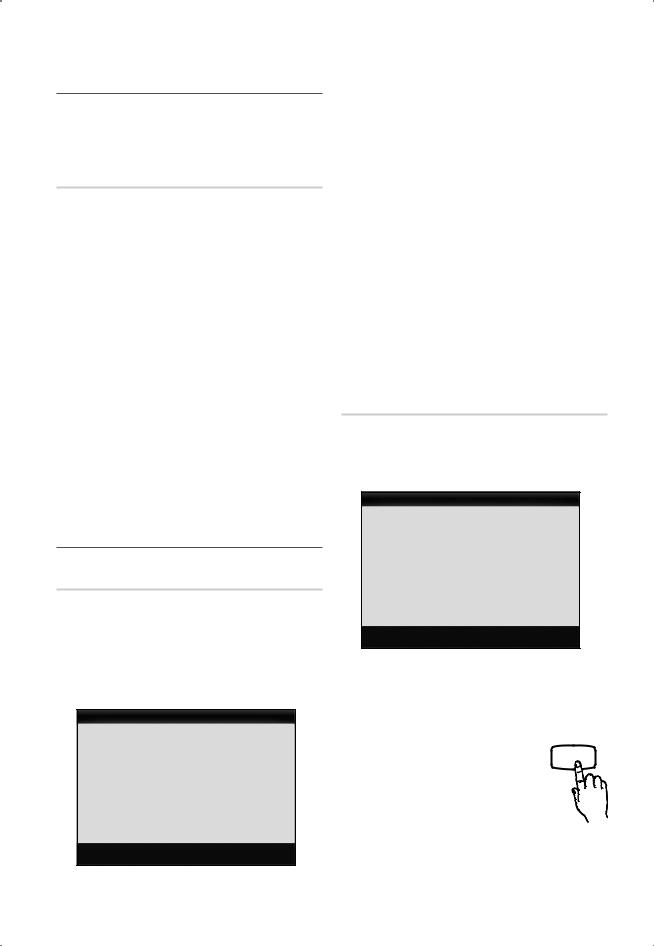
Basic Features
¦¦ Economical Solutions
OO MENUm → Picture → Eco Solution → ENTERE
The Eco Function can be used to enhance your power savings.
Eco Solution
■■ Energy Saving (Off / Low / Medium / High / Picture Off) t: This adjusts the brightness of the TV in order to reduce power consumption. If you select Picture Off, the screen is turned off, but the sound remains on. Press any button except volume button to turn on the screen. Until the screen turns on again, a distorted picture will be displayed for about 4 seconds.
■■ Eco Sensor (Off / On): To enhance your power savings; the picture settings will automatically adapt to the light in the room.
If you adjusts the Cell Light, the Eco Sensor will be set to Off.
Min Cell Light: When Eco Sensor is On, the minimum screen brightness can be adjusted manually.
If Eco Sensor is On, the display brightness may change (become slightly darker or brighter) depending on the surrounding light intensity.
■■ No Signal Power Off (Off / 15 min. / 30 min. /
60 min.): To avoid unnecessary energy consumption, set how long you want the TV to remain on if it’s not receiving a signal.
Disabled when the PC is in power saving mode.
¦¦ Changing the Picture Options
Advanced Settings
OO MENUm → Picture → Advanced Settings → ENTERE
(Advanced Settings are available in Standard / Movie mode)
Compared to previous models, new Samsung TVs have a more precise picture.
In PC mode, you can only make changes to
Dynamic Contrast, Gamma and White Balance.
Advanced Settings
Black Tone |
: Off |
► |
Dynamic Contrast |
: Medium |
|
Gamma |
: 0 |
|
RGB Only Mode |
: Off |
|
Color Space |
: Native |
|
White Balance |
|
|
Flesh Tone |
: 0 |
|
|
▼ |
|
|
UMove E Enter |
R Return |
■■ Black Tone (Off / Dark / Darker / Darkest): Select the black level to adjust the screen depth.
■■ Dynamic Contrast (Off / Low / Medium / High): Adjust the screen contrast.
■■ Gamma: Adjust the primary color intensity.
■■ RGB Only Mode (Off / Red / Green / Blue): Displays the Red, Green and Blue color for making fine adjustments to the hue and saturation.
■■ Color Space (Auto / Native): Adjust the range of colors available to create the image.
■■ White Balance: Adjust the color temperature for a more natural picture.
R-Offset / G-Offset / B-Offset: Adjust each color’s (red, green, blue) darkness.
R-Gain / G-Gain / B-Gain: Adjust each color’s (red, green, blue) brightness.
Reset: Resets the White Balance to it’s default settings. ■■ Flesh Tone: Emphasize pink “Flesh Tone.”
■■ Edge Enhancement (Off / On): Emphasize object boundaries.
Picture Options
OO MENUm → Picture → Picture Options→ ENTERE
In PC mode, you can only make changes to the
Color Tone, Size and Screen Burn Protection.
Picture Options
Color Tone |
: Normal |
► |
Size |
: 16:9 |
|
Digital Noise Filter |
:Auto |
|
MPEG Noise Filter |
:Auto |
|
HDMI Black Level |
: Normal |
|
Film Mode |
: Off |
|
Screen Burn Protection |
|
|
|
UMove E Enter |
R Return |
■■ Color Tone (Cool / Normal / Warm1 / Warm2)
Warm1 or Warm2 will be deactivated when the picture mode is Dynamic.
Settings can be adjusted and stored for each external device connected to an input on the TV.
■■ Size: Your cable box/satellite receiver |
P.SIZE |
may have its own set of screen sizes as |
|
well. However, we highly recommend you |
|
use 16:9 mode most of the time. |
|
14 English

16:9 : Sets the picture to 16:9 wide mode. Zoom1: Use for moderate magnification. Zoom2: Use for a stronger magnification.
Wide Fit: Enlarges the aspect ratio of the picture to fit the entire screen.
Available with HD 1080i / 720p signals in 16:9 mode..
4:3 : Sets the picture to basic (4:3) mode.
Do not watch in 4:3 format for a long time. Traces of borders displayed on the left, right and center of the screen may cause image retention(screen burn) which are not covered by the warranty.
Screen Fit: Displays the full image without any cut-off when HDMI (720p / 1080i / 1080p) or Component (1080i / 1080p) signals are inputted.
NOTE
xx After selecting Zoom1, Zoom2 or Wide Fit:
1.Press the ► button to select Position.
2.Press the ENTERE button.
3.Press the ▲ or ▼ button to move the picture up or down.
4.Press the ENTERE button.
5.Press the ► button to select Reset.
6.Press the ENTERE button to reset the picture to its default position.
xx After selecting Screen Fit in HDMI (1080i/1080p) or Component (1080i/1080p) mode, you may need to center the picture:
1.Press the ◄ or ► button to select Position.
2.Press the ENTERE button.
3.Press the ▲, ▼, ◄ or ► button to move the picture.
4.Press the ENTERE button.
5.Press the ◄ or ► button to select Reset.
6.Press the ENTERE button.
xx HD (High Definition): 16:9 - 1080i/1080p (1920x1080), 720p (1280x720)
xx Settings can be adjusted and stored for each external device you have connected to an input on the TV.
Input Source |
Picture Size |
TV, AV, Component (480i, |
16:9, Zoom1, |
480p) |
Zoom2, 4:3 |
Component (1080i, 1080p), |
16:9, Wide Fit, 4:3, |
HDMI (720p, 1080i, 1080p) |
Screen Fit |
PC |
16:9, 4:3 |
■■ Digital Noise Filter (Off / Low / Medium / High / Auto / Auto Visualisation / Demo): If the broadcast signal received by your TV is weak, you can activate the Digital Noise Filter feature to reduce any static and ghosting that may appear on the screen.
When the signal is weak, try other options until the best picture is displayed.
Auto Visualisation: When changing analog channels, displays signal strength.
Only available for analog channels.
When bar is green, is that the best possible signal.
■■ MPEG Noise Filter (Off / Low / Medium / High / Auto): Reduces MPEG noise to provide improved picture quality.
■■ HDMI Black Level (Normal / Low): Selects the black level on the screen to adjust the screen depth.
Available only in HDMI mode.
■■ Film Mode (Off / Auto1 / Auto2): Sets the TV to automatically sense and process film signals from all sources and adjusts the picture for optimum quality.
Available in TV, AV, COMPONENT (480i / 1080i) and HDMI (480i / 1080i).
■■ Screen Burn Protection: To reduce the possibility of screen burn, this unit is equipped with screen burn prevention technology. The Time setting allows you to program the time between movement of the picture in minutes.
Pixel Shift (Off / On): Using this function, you can minutely move pixels on the PDP in horizontal or vertical direction to minimize after-images on the screen.
Optimum condition for pixel shift
|
Item |
TV/AV/Component/ |
|
HDMI/PC |
|
|
|
|
Horizontal |
0~4 |
4 |
|
|
|
Vertical |
0~4 |
4 |
|
|
|
Time (minute) |
1~4 min. |
4 min. |
The Pixel Shift value may differ depending on the TV size (inches) and mode.
This function is not available in the Screen Fit mode.
Auto Protection Time (10 min. / 20 min. / 40 min. / 1 hour / Off) : Set the time the screen remains idle with a still image until the screen saver is activated. The
Screen Saver prevents the formation of ghost images on the screen.
Features Basic 03
English 15

Basic Features
Scrolling: This function removes after-images on the screen by moving all the pixels on the PDP according to a pattern. Use this function when there are remaining after-images or symbols on the screen, especially when you displayed a still image on the screen for a long time.
The after-image removal function has to be executed for a long time (approximately 1 hour) to effectively remove after-images on the screen. If the after-image is not removed after performing the function, repeat the function again.
Press any key on the remote control to cancel this feature.
Side Gray (Light / Dark): When you watch TV with the screen ratio set to 4:3, the screen is prevented from any damage by adjusting the white balance on both extreme left and right sides.
Picture Reset (OK / Cancel)
Resets your current picture mode to its default settings.
¦¦ Setting up the TV with Your PC
Set the input source to PC.
OO MENUm → Picture →ENTERE
Auto Adjustment t
Adjust frequency values/positions and fine tune the settings automatically.
Not available when connecting with an HDMI/DVI cable.
Screen
■■ Coarse / Fine: Removes or reduces picture noise. If the noise is not removed by Fine-tuning alone, then adjust the frequency as best as possible (Coarse) and Finetune again. After the noise has been reduced, readjust the picture so that it is aligned to the center of screen.
■■ Position: Adjust the PC’s screen positioning if it does not fit the TV screen. Press the ▲ or ▼ button to adjust the Vertical-Position. Press the ◄ or ► button to adjust the Horizontal-Position.
■■ Image Reset: Resets the image to default settings.
Using Your TV as a Computer (PC) Display
Setting Up Your PC Software (Based on Windows XP)
Depending on the version of Windows and the video card, the actual screens on your PC will probably look different, but the same basic set-up information will apply in most cases. (If not, contact your computer manufacturer or Samsung Dealer.)
1.Click on “Control Panel” on the Windows start menu.
2.Click on “Appearance and Themes” in the “Control Panel” window and a display dialog-box will appear.
16 English
3.Click on “Display” and a display dialog box will appear.
4.Navigate to the “Settings” tab on the display dialog-box.
––The correct size setting (resolution)
[Optimum: 42": 1024 X 768 / 50": 1360 X 768 pixels]
––If a vertical-frequency option exists on your display settings dialog box, the correct value is ‘60’ or ‘60 Hz’. Otherwise, just click ‘OK’ and exit the dialog box.
Sound Menu
¦¦ Changing the Preset Sound Mode
OO MENUm → Sound → Mode → ENTERE
Mode
■■ Standard: Selects the normal sound
mode. S.MODE
■■ Music: Emphasizes music over voices.
■■ Movie: Provides the best sound for movies.
■■ Clear Voice: Emphasizes voices over other sounds.
■■ Amplify: Increase the intensity of high-frequency sound to allow a better listening experience for the hearing impaired.
¦¦ Adjusting Sound Settings
OO MENUm → Sound → Equalizer → ENTERE
Equalizer
Adjusts the sound mode (standard sound mode only).
■■ Balance L/R: Adjusts the balance between the right and left speaker.
■■ 100Hz / 300Hz / 1kHz / 3kHz / 10kHz (Bandwidth Adjustment): Adjusts the level of specific bandwidth frequencies.
■■ Reset: Resets the equalizer to its default settings.
¦¦ Sound Settings
Virtual Surround (Off / On)
(standard sound mode only)
This function provides a virtual 5.1 channel surround sound experience through a pair of speakers using HRTF (Head Related Transfer Function) technology.

Dialog Clarity (Off / On)
(standard sound mode only)
This function allows you to increase the intensity of a voice over background music or sound effects so that dialog can be heard more clearly.
Preferred Language
(digital channels only) |
MTS |
Digital-TV broadcasts are capable of |
|
simultaneous transmission of many audio |
|
tracks (for example, simultaneous translations |
|
of the program into foreign languages). |
|
Not available in some locations.
You can only select a language among the ones being broadcasted.
Multi-Track Sound (MTS) t
■■ Mono: Choose for channels that are |
MTS |
broadcasting in mono or if you are having |
|
difficulty receiving a stereo signal. |
|
■■ Stereo: Choose for channels that are broadcasting in stereo.
■■ SAP: Choose to listen to the Separate Audio Program, which is usually a foreign-language translation.
Depending on the particular program being broadcast, you can listen to Mono, Stereo or SAP.
Auto Volume (Off / Normal / Night)
To equalize the volume level on each channel, set to Normal.
■■ Night: This mode provides an improved sound experience compared to Normal mode, making almost no noise. It is useful at night.
Speaker Select (External Speaker /
TV Speaker)
A sound echo may occur due to a difference in decoding speed between the main speaker and the audio receiver. In this case, set the TV to External Speaker.
When Speaker Select is set to External Speaker, the volume and MUTE buttons will not operate and the sound settings will be limited.
When Speaker Select is set to External Speaker xx TV Speaker: Off , External Speaker: On
When Speaker Select is set to TV Speaker xx TV Speaker: On , External Speaker: On
If there is no video signal, both speakers will be mute.
SPDIF Output
SPDIF (Sony Philips Digital Interface) is used to provide digital sound, reducing interference going to speakers and various digital devices such as an A/V Receiver/Home theater.
■■ Audio Format: During the reception of a digital TV broadcast, you can select the Digital Audio output (SPDIF) format from the options PCM, or Dolby Digital.
■■ Audio Delay: Correct audio-video sync problems, when watching TV or video, and when listening to digital audio output using an external device such as an AV receiver (0ms ~ 250ms).
FM Transmitter
(Not available in some locations)
You can listen to TV sound from FM receiver speaker by transmitting audio signals by FM frequencies.
For more detailed information, refer to “FM Transmitter Setup” (p. 31).
Connecting a FM Transmitter
Insert FM Transmitter Module into the Socket which is located at the back side of TV.
TV Side Panel
FM Transmitter
■■ FM Transmitter (Off / On): Turns FM transmitter on/off. ■■ FM Frequency: Sets FM transmitter frequency.
Sound Reset (OK / Cancel)
Restore all sound settings to the factory defaults.
Setup Menu
¦¦ Setting the Time
OO MENUm → Setup → Time → ENTERE
Time
■■ Time: Setting the clock is for using various timer features of the TV.
OO The current time will appear every time you press the INFO button.
English 17
Features Basic 03

Basic Features
If you disconnect the power cord, you have to set the clock again.
Clock: Set the Day, Month, Year, Hour, Minute and am/pm manually.
You can set the Day, Month, Year, Hour and
Minute directly by pressing the number buttons on the remote control.
¦¦ Using the Sleep Timer
OO MENUm → Setup → Time → Sleep Timer →
ENTERE
■■ Sleep Timer: Automatically shuts down |
SLEEP |
the TV after a preset period of time. (30, |
|
60, 90, 120, 150 and 180 minutes). |
|
To cancel the Sleep Timer, select |
|
Off. |
|
¦¦ Setting the On / Off Timer
OO MENUm → Setup → Time → Timer 1 → ENTERE
You can set the TV to turn on automatically at a preset time.
■■ Timer 1 / Timer 2 / Timer 3: Three different on / off timer settings can be made.
You must set the clock first.
Timer 1
On Time
▲ |
|
|
|
|
|
|
|
|
|
|
|
|
|
|
|
|
|
|
|
Inactivate |
|
|
|
00 |
|
|
|
|
00 |
|
|
|
|
am |
|
|
|
||
▼ |
|
|
|
|
|
|
|
|
|
|
|
|
|
|
|
|
|
|
|
Off Time |
|
|
|
|
|
|
|
|
|
|
|
|
|
|
|
|
|
|
|
Inactivate |
|
|
|
00 |
|
|
|
|
00 |
|
|
|
|
am |
|
|
|
||
Volume |
|
Source |
|
|
|
|
Antenna |
|
|
Channel |
|
|
|
||||||
20 |
|
|
|
TV |
|
|
|
Air |
|
|
|
|
3 |
|
|
|
|||
|
|
|
|
|
|
|
|
|
|
|
|
|
|
|
|
|
|
|
|
Repeat |
|
|
Sun |
Mon |
|
|
Tue |
Wed |
|
Thu |
Fri |
Sat |
|
||||||
Once |
|
|
|
|
|
|
|
|
|
|
|
|
|
|
|
|
|
|
|
|
|
|
|
|
|
|
|
|
|
|
|
|
|
|
|
|
|
|
|
|
|
LMove |
U Adjust |
E Enter |
R Return |
|
|||||||||||||
On Time / Off Time: Set the hour, minute, and activate / inactivate. (To activate the timer with the setting you’ve chosen, set to Activate.)
Volume: Set the desired volume level.
Source : Select TV or USB content to be played when the TV is turned on automatically. (USB can be selected only when a USB device is connected to the TV)
Antenna (when Source is set to TV): Select Air or
Cable.
Channel (when the Source is set to TV): Select the desired channel.
Contents (when the Source is set to USB): Select a folder in the USB device containing music or photo files to be played when the TV is turned on automatically.
18 English
NOTE
xx If there is no music file on the USB device or the folder containing a music file is not selected, the Timer function does not operate correctly.
xx When there is only one photo file in the USB, the Slide Show will not play.
xx If a folder name is too long, the folder cannot be selected.
xx Each USB you use is assigned its own folder. When using more than one of the same type of USB, make sure the folders assigned to each USB have different names.
Repeat: Select Once, Everyday, Mon~Fri, Mon~Sat, Sat~Sun or Manual to set at you convenience. If you select Manual, you can set up the day you want to activate the timer.
The c mark indicates the day is selected.
Auto Power Off (available only when the TV is turned on by the Timer): The TV will be automatically turned off after 3 hours of being left idle to prevent overheating.
¦¦ Other Features
OO MENUm → Setup → ENTERE
Menu Language
Set the menu language.
1.Select Menu Language and press the ENTERE button.
2.Choose desired language and press the ENTERE button.
Caption
(On-Screen Text Messages)
■■ Caption (Off / On): You can switch the caption function on or off. If captions are not available, they will not be displayed on the screen.
The Caption feature doesn’t work in Component, HDMI or PC modes.
■■ Caption Mode: You can select the desired caption mode.
The availability of captions depends on the program being broadcast.
CC1~CC4 / Text1~Text4: The Analog Caption function operates in either analog TV channel mode or when a signal is supplied from an external device to the TV.
Service1~Service6 / CC1~CC4 / Text1~Text4: (digital channels only) The Digital Captions function works with digital channels.
Not available in some locations.

Service1~6 may not be available in digital caption mode depending on the broadcast.
■■ Digital Caption Options: (digital channels only)Not available in some locations.
Size: Options include Default, Small, Standard and Large. The default is Standard.
Font Style: Options include Default and Styles 0 to 7. The default is Style 0.
Foreground Color: Options include Default, White, Black, Red, Green, Blue, Yellow, Magenta and Cyan. You can change the color of the letter. The default is White.
Background Color: Options include Default, White, Black, Red, Green, Blue, Yellow, Magenta and Cyan. You can change the background color of the caption. The default is Black.
Foreground Opacity: This adjusts the opacity of text. Options include Default, Transparent, Translucent, Solid and Flashing.
Background Opacity: This adjusts the opacity of the caption background. Options include Default, Transparent, Translucent, Solid and Flashing.
Return to Default: This option sets each Size, Font Style, Foreground Color, Background Color, Foreground
Opacity and Background Opacity to its default.
NOTE
xx Digital Caption Options are available only when Service1 ~ Service6 can be selected in Caption Mode.
xx The availability of captions depends on the program being broadcasted.
xx The Foreground and Background cannot be set to have the same color.
xx You cannot set both the Foreground Opacity and the Background Opacity to Transparent.
General
■■ Game Mode (Off / On): When connecting to a game console such as PlayStation™ or Xbox™, you can enjoy a more realistic gaming experience by selecting the game menu.
NOTE
xx Precautions and limitations for game mode
––To disconnect the game console and connect another external device, set Game Mode to Off in the setup menu.
––If you display the TV menu in Game Mode, the screen shakes slightly.
xx Game Mode is not available when the input source is set to TV or PC.
xx After connecting the game console, set Game Mode to On. Unfortunately, you may notice reduced picture quality.
xx If Game Mode is On:
––Picture mode is set to Standard and Sound mode is set to Movie.
––Equalizer is not available.
■■ Menu Transparency (Bright / Dark): Set the Transparency of the menu.
■■ Melody (Off / Low / Medium / High): Set so that a melody plays when the TV is turned on or off.
■■ AV Color System (Auto, PAL-M, PAL-N, NTSC): You can set the color encoding standards for external signal inputs. Normally the TV can receive image and sound with good quality in Auto mode. This mode detects the color signal sources automatically. If the color implementation is unsatisfactory, select any of PAL-M, PAL-N or NTSC.
This function is available only in AV mode.
¦¦ Picture In Picture (PIP)
PIP t
You can watch the TV tuner and one external video source simultaneously. PIP (Picture-in-Picture) does not function in the same mode.
OO MENUm → Setup → PIP → ENTERE
NOTE
xx For PIP sound, refer to the Sound Select instructions.
xx If you turn the TV off while watching in PIP mode, the PIP window will disappear.
xx You may notice that the picture in the PIP window becomes slightly unnatural when you use the main screen to view a game or karaoke.
xx PIP Settings
Main picture |
Sub picture |
|
Component1, 2, HDMI1/ |
TV |
|
DVI, HDMI2, HDMI3, PC |
||
|
■■ PIP (Off / On): Activate or deactivate the PIP function.
■■ Air/Cable (Air / Cable): Select either Air or Cable as the input source for the sub-screen.
■■ Channel: Select the channel for the sub-screen. ■■ Size (Õ / Ã): Select a size for the sub-picture.
■■ Position (à / – / — / œ): Select a position for the sub-picture.
■■ Sound Select (Main / Sub): You can choose the desired sound (Main / Sub) in PIP mode.
Features Basic 03
English 19
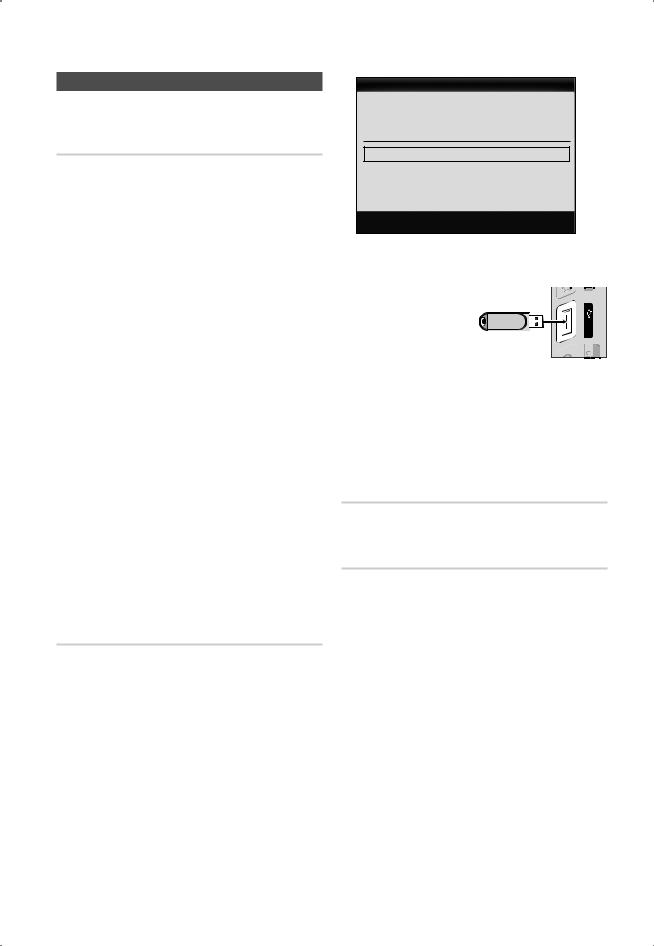
Basic Features
Support Menu
OO MENUm → Support → ENTERE
Self Diagnosis
Self Diagnostic might take few seconds, this is part of the normal operation of the TV.
■■ Picture Test: Use to check for picture problems.
Yes: If the test pattern does not appear or there is noise in the test pattern, select Yes. There may be a problem with the TV. Contact Samsung’s Call Center for assistance.
No: If the test pattern is properly displayed, select No. There may be a problem with your external equipment. Please check your connections. If the problem still persists, refer to the external device’s user manual.
■■ Sound Test: Use the built-in melody sound to check for sound problems.
If you hear no sound from the TV’s speakers, before performing the sound test, make sure
Speaker Select is set to TV Speaker in the Sound menu.
The melody will be heard during the test even if
Speaker Select is set to External Speaker or the sound is muted by pressing the MUTE button.
Yes: If you can hear sound only from one speaker or not at all during the sound test, select Yes. There may be a problem with the TV. Contact Samsung’s Call Center for assistance.
No: If you can hear sound from the speakers, select No. There may be a problem with your external equipment. Please check your connections. If the problem persists, refer to the external device’s user manual.
■■ Troubleshooting: If the TV seems to have a problem, refer to this description.
If none of these troubleshooting tips apply, contact the Samsung customer service center.
Software Upgrade
Software Upgrade can be performed downloading the latest firmware from “www.samsung.com,” to a USB memory device.
Current Version - the software already installed in the TV.Software is represented as ‘Year/Month/Day_Version’.
Software Upgrade
Current Version
By USB
Alternative Software
Installing the Latest Version
■■ By USB: Insert a USB
drive containing the firmware upgrade file,
downloaded from “www. samsung.com,” into the TV. Please be careful not
to disconnect the power or remove the USB
drive until upgrades are complete. The TV will be turned off and on automatically after completing the firmware upgrade. When software is upgraded, video and audio settings you have made will return to their default settings. We advise you to to write down your settings so that you can easily reset them after the upgrade.
■■ Alternative Software (Not available)
HD Connection Guide
Refer to this information when connecting external devices to the TV.
Contact Samsung
View this information when your TV does not work properly or when you want to upgrade the software. You can find information regarding our call centers and how to download products and software.
20 English
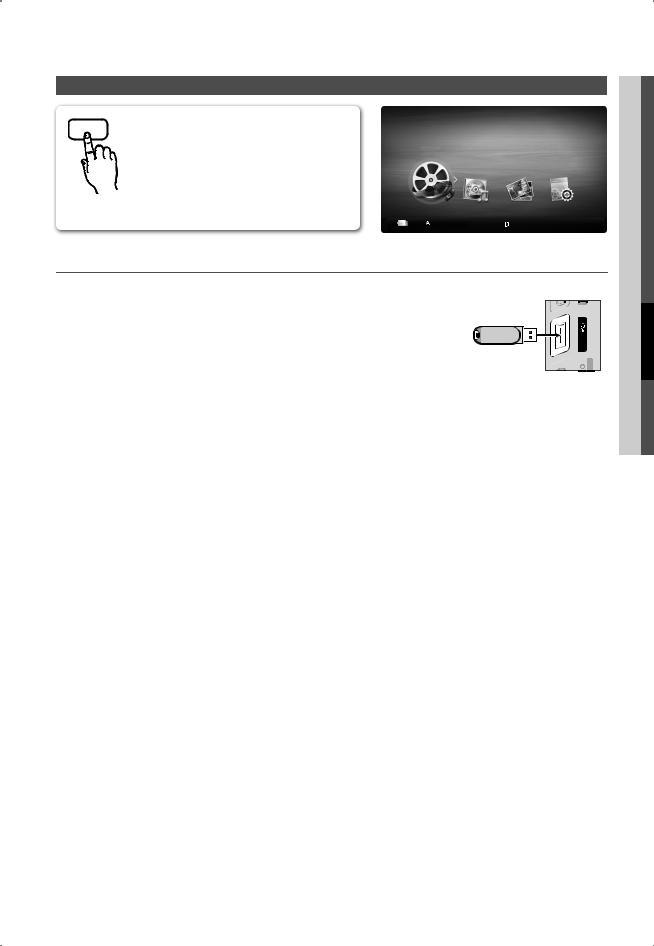
Advanced Features
|
Media Play |
MEDIA.P |
Enjoy photos, music and/or movie fi les saved on |
a USB Mass Storage Class (MSC) device. |
|
|
O MENUm → Application → Media Play |
|
(USB) → ENTERE |
MediaPlay
Videos
SUM |
|
Change Device |
|
View Devices E Enter R Return |
|
|
|||
|
|
|
|
|
¦ Connecting a USB Device
1.Turn on your TV.
2.Connect a USB device containing photo, music and/or movie fi les to the USB jack on the side of the TV.
3. When USB is connected to the TV, popup window appears. Then you can select
Media Play.
USB Drive
It might not work properly with unlicensed multimedia files.
Need-to-Know List before using Media Play (USB)
TV Side Panel
USB
xMTP (Media Transfer Protocol) is not supported.
xThe file system supports FAT16, FAT32 and NTFS.
xCertain types of USB Digital camera and audio devices may not be compatible with this TV.
xMedia Play only supports USB Mass Storage Class (MSC) devices. MSC is a Mass Storage Class Bulk-Only Transport device. Examples of MSC are Thumb drives, Flash Card Readers and USB HDD (USB HUB are not supported). Devices should be connected directly to the TV’s USB port.
xBefore connecting your device to the TV, please back up your files to prevent them from damage or loss of data. SAMSUNG is not responsible for any data file damage or data loss.
xConnect a USB HDD to the dedicated port, USB port.
xDo not disconnect the USB device while it is loading.
xThe higher the resolution of the image, the longer it takes to display on the screen.
xThe maximum supported JPEG resolution is 15360X8640 pixels.
xFor unsupported or corrupted files, the “Not Supported File Format” message is displayed.
xIf the files are sorted by Basic View, up to 1000 files can be displayed in each folder.
xMP3 files with DRM that have been downloaded from a non-free site cannot be played. Digital Rights Management (DRM) is a technology that supports the creation, distribution and management of the content in an integrated and comprehensive way, including the protection of the rights and interests of the content providers, the prevention of the illegal copying of contents, as well as managing billings and settlements.
xIf more than 2 PTP devices are connected, you can only use one at a time.
xIf more than two MSC devices are connected, some of them may not be recognized. A USB device that requires high power (more than 500mA or 5V) may not be supported.
xIf an over-power warning message is displayed while you are connecting or using a USB device, the device may not be recognized or may malfunction.
Features Advanced 04
English 21
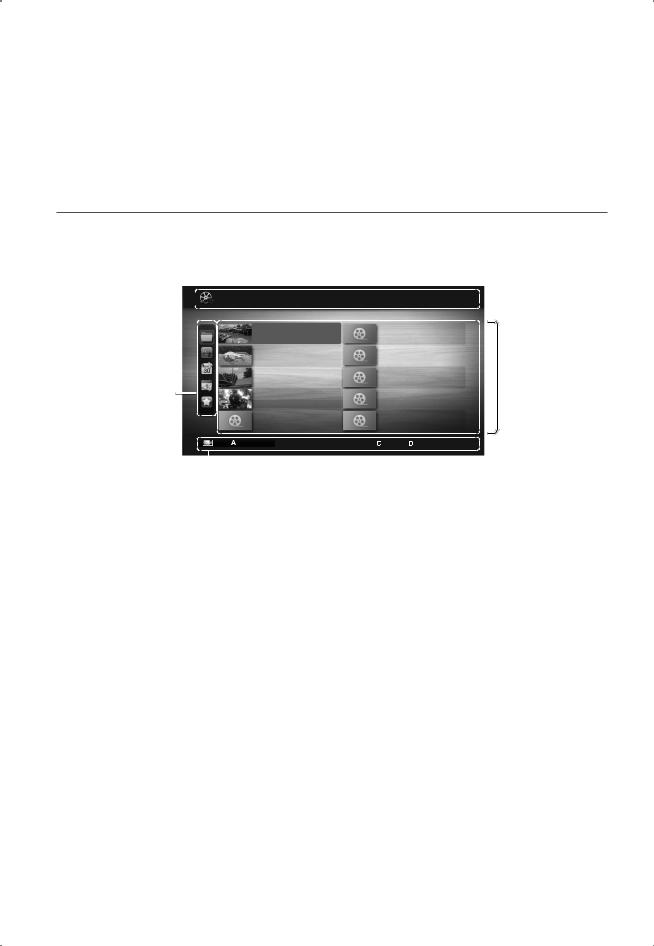
Advanced Features
xx If the TV has been no input during time set in Auto Protection Time, the Screensaver will run.
xx The power-saving mode of some external hard disk drives may be released automatically when connected to the TV. xx If a USB extension cable is used, the USB device may not be recognized or the files on the device may not be read.
xx If a USB device connected to the TV is not recognized, the list of files on the device is corrupted or a file in the list is not played, connect the USB device to the PC, format the device and check the connection.
xx If a file deleted from the PC is still found when Media Play is run, use the “Empty the Recycle Bin” function on the PC to permanently delete the file.
¦¦ Screen Display
Move to the desired file using the up/down/right/left buttons and then press the ENTERE or (Play) button. The file is played.
Supports the View Devices and Home in Media Play homepage.
Information: 
 You can ascertain the selected
You can ascertain the selected
file name and the number of files and page.
Sort List Section: Displays the sorting standard.
The sorting standard is different depending on the contents.
Videos |
/Movie 01.avi |
|
|
|
|
1/1 Page |
||
|
|
|
Movie 01.avi |
Movie 02.avi |
|
|||
|
|
|
Jan.10.2010 |
|
|
|
|
Jan.10.2010 |
|
|
|
Movie 03.avi |
Movie 04.avi |
|
|||
|
|
|
Jan.10.2010 |
|
|
|
|
Jan.10.2010 |
|
|
|
Movie 05.avi |
Movie 06.avi |
|
|||
|
|
|
Jan.10.2010 |
|
|
|
|
Jan.10.2010 |
|
|
|
Movie 07.avi |
Movie 08.avi |
|
|||
|
|
|
Jan.10.2010 |
|
|
|
|
Jan.10.2010 |
|
|
|
Movie 09.avi |
Movie 10.avi |
|
|||
|
|
|
Jan.10.2010 |
|
|
|
|
Jan.10.2010 |
SUM |
|
Change Device |
|
Select |
|
|
Sorting T Tools |
|
|
|
|
|
|||||
File List Section:
You can confirm the files and groups that are sorted by category.

 Operation Buttons
Operation Buttons
 Red (Change Device): Selects a connected device.
Red (Change Device): Selects a connected device.
 Green (Preference): Sets the file preference. (not supported in Basic view)
Green (Preference): Sets the file preference. (not supported in Basic view)
 Yellow (Select): Selects multiple files from file list. Selected files are marked with a symbol.
Yellow (Select): Selects multiple files from file list. Selected files are marked with a symbol.
 Blue (Sorting): Selects the sort list. TTools: Displays the option menu.
Blue (Sorting): Selects the sort list. TTools: Displays the option menu.
Using the (REW) or µ(FF) button, file list can move to next or previous page.
22 English

Videos
Playing Video
1.Press the ◄ or ► button to select Videos, then press the ENTERE button in the Media Play menu.
2.Press the ◄/►/▲/▼ button to select the desired video in the file list.
3.Press the ENTERE button or (Play) button.
––The selected file is displayed on the top with its playing time.
––If video time information is unknown, play time and progress bar are not displayed.
––During video playback, you can search using the ◄ and ► button.
In this mode, you can enjoy movie clips contained on a Game, |
|
|
|
|
|||||||||||
|
but you cannot play the Game itself. |
|
|
|
|
|
Movie 01.avi |
00:04:03 / 00:07:38 |
1/1 |
||||||
yy Supported Subtitle Formats |
|
|
|
|
|
|
|
|
|
||||||
|
|
|
|
|
|
|
|
|
|
||||||
|
|
|
|
|
|
|
|
|
|
|
|
|
|
|
|
|
Name |
|
|
|
File extension |
|
Format |
|
|
|
|
||||
|
|
|
|
|
|
|
|
|
|
|
|
|
|
|
|
|
MPEG-4 time-based text |
|
|
.ttxt |
|
|
XML |
|
|
|
|
||||
|
|
|
|
|
|
|
|
|
|
|
|
|
|
|
|
|
SAMI |
|
|
|
.smi |
|
HTML |
|
|
|
|
|
|||
|
SubRip |
|
|
|
.srt |
|
string-based |
|
|
|
|
||||
|
|
|
|
|
|
|
|
|
|
|
|
|
|
|
|
|
SubViewer |
|
|
|
.sub |
|
string-based |
|
|
|
|
|
|||
|
Micro DVD |
|
|
|
.sub or .txt |
|
string-based |
|
|
|
|
||||
|
|
|
|
|
|
|
|
|
|
|
|
SUM |
|
EPause L Jump T Tools R Return |
|
|
|
|
|
|
|
|
|
|
|
|
|
|
|||
yy Supported Video Formats |
|
|
|
|
|
|
|
|
|
|
|||||
|
|
|
|
|
|
|
|
|
|
|
|
|
|
|
|
|
File Extension |
Container |
|
Video Codec |
|
|
Resolution |
Frame rate |
Bit rate |
Audio Codec |
|||||
|
|
|
|
(fps) |
(Mbps) |
||||||||||
|
|
|
|
|
|
|
|
|
|
|
|
|
|||
|
|
|
|
|
|
|
|
|
|
|
|
|
|||
|
|
|
|
|
|
Divx 3.11 / 4.x / 5.1 / 6.0 |
|
1920x1080 |
6 |
~ 30 |
8 |
|
|||
|
|
|
|
|
|
|
|
|
|
|
|
|
|
||
|
*.avi |
|
AVI |
|
XviD |
|
|
1920x1080 |
6 |
~ 30 |
8 |
MP3 / AC3 / LPCM / |
|||
|
|
|
|
|
|
|
|
|
|
|
|
||||
|
*.mkv |
|
MKV |
|
H.264 BP / MP / HP |
|
1920x1080 |
6 |
~ 30 |
25 |
ADPCM / DTS Core |
||||
|
|
|
|
|
|
|
|
||||||||
|
|
|
|
|
|
|
|
|
|
|
|
|
|
||
|
|
|
|
|
|
MPEG4 SP / ASP |
|
|
1920x1080 |
6 |
~ 30 |
8 |
|
||
|
|
|
|
|
|
|
|
|
|
|
|
|
|||
|
|
|
|
|
|
Divx 3.11 / 4.x / 5.1 / 6.0 |
|
1920x1080 |
6 |
~ 30 |
8 |
|
|||
|
|
|
|
|
|
|
|
|
|
|
|
|
|
||
|
*.asf |
|
ASF |
|
XviD |
|
|
1920x1080 |
6 |
~ 30 |
8 |
MP3 / AC3 / LPCM / |
|||
|
|
|
|
|
|
|
|
|
|
|
|
||||
|
|
|
H.264 BP / MP / HP |
|
1920x1080 |
6 |
~ 30 |
25 |
ADPCM / WMA |
||||||
|
|
|
|
|
|
|
|||||||||
|
|
|
|
|
|
|
|
||||||||
|
|
|
|
|
|
|
|
|
|
|
|
|
|
||
|
|
|
|
|
|
MPEG4 SP / ASP |
|
|
1920x1080 |
6 |
~ 30 |
8 |
|
||
|
|
|
|
|
|
|
|
|
|
|
|
||||
|
*.wmv |
|
ASF |
|
Window Media Video v9 |
|
1920x1080 |
6 |
~ 30 |
25 |
WMA |
||||
|
|
|
|
|
|
|
|
|
|
|
|
|
|||
|
|
|
|
|
|
H.264 BP / MP / HP |
|
1920x1080 |
6 |
~ 30 |
25 |
|
|||
|
|
|
|
|
|
|
|
|
|
|
|
|
|||
|
*.mp4 |
|
MP4 |
|
MPEG4 SP / ASP |
|
|
1920x1080 |
6 |
~ 30 |
8 |
MP3 / ADPCM / AAC |
|||
|
|
|
|
|
|
|
|
|
|
|
|
|
|
||
|
|
|
|
|
|
XVID |
|
|
1920x1080 |
6 |
~ 30 |
8 |
|
||
|
|
|
|
|
|
|
|
|
|
|
|
|
|||
|
*.3gp |
|
3GPP |
|
H.264 BP / MP / HP |
|
1920x1080 |
6 |
~ 30 |
25 |
ADPCM / AAC / HE-AAC |
||||
|
|
|
|
|
|
|
|
|
|
|
|
||||
|
|
|
MPEG4 SP / ASP |
|
|
1920x1080 |
6 |
~ 30 |
8 |
||||||
|
|
|
|
|
|
|
|
|
|||||||
|
|
|
|
|
|
|
|
|
|
|
|
|
|||
|
*.vro |
|
VRO |
|
MPEG1 |
|
|
1920x1080 |
24 / 25 / 30 |
30 |
AC3 / MPEG / LPCM |
||||
|
|
|
|
|
|
|
|
|
|
|
|
||||
|
|
VOB |
|
MPEG2 |
|
|
1920x1080 |
24 / 25 / 30 |
30 |
||||||
|
|
|
|
|
|
|
|||||||||
|
|
|
|
|
|
|
|
|
|||||||
|
|
|
|
|
|
|
|
|
|
|
|
|
|||
|
|
|
|
|
|
MPEG1 |
|
|
1920x1080 |
24 / 25 / 30 |
30 |
|
|||
|
*.mpg |
|
|
|
|
|
|
|
|
|
|
|
|
|
|
|
|
PS |
|
MPEG2 |
|
|
1920x1080 |
24 / 25 / 30 |
30 |
AC3 / MPEG / LPCM / AAC |
|||||
|
*.mpeg |
|
|
|
|
||||||||||
|
|
|
|
|
|
|
|
|
|
|
|
|
|
|
|
|
|
|
|
|
|
H.264 |
|
|
1920x1080 |
6 ~ 30 |
25 |
|
|||
|
|
|
|
|
|
|
|
|
|
|
|
|
|||
|
*.ts |
|
|
|
|
MPEG2 |
|
|
1920x1080 |
24 / 25 / 30 |
30 |
|
|||
|
|
|
|
|
|
|
|
|
|
|
|
|
|
AC3 / AAC / MP3 / DD+ / |
|
|
*.tp |
|
TS |
|
H.264 |
|
|
1920x1080 |
6 ~ 30 |
25 |
|||||
|
|
|
|
|
HE-AAC |
||||||||||
|
*.trp |
|
|
|
|
|
|
|
|
|
|
|
|
|
|
|
|
|
|
|
VC1 |
|
|
1920x1080 |
6 ~ 30 |
25 |
|
||||
|
|
|
|
|
|
|
|
|
|||||||
|
|
|
|
|
|
|
|
|
|
|
|
|
|
|
|
Features Advanced 04
English 23
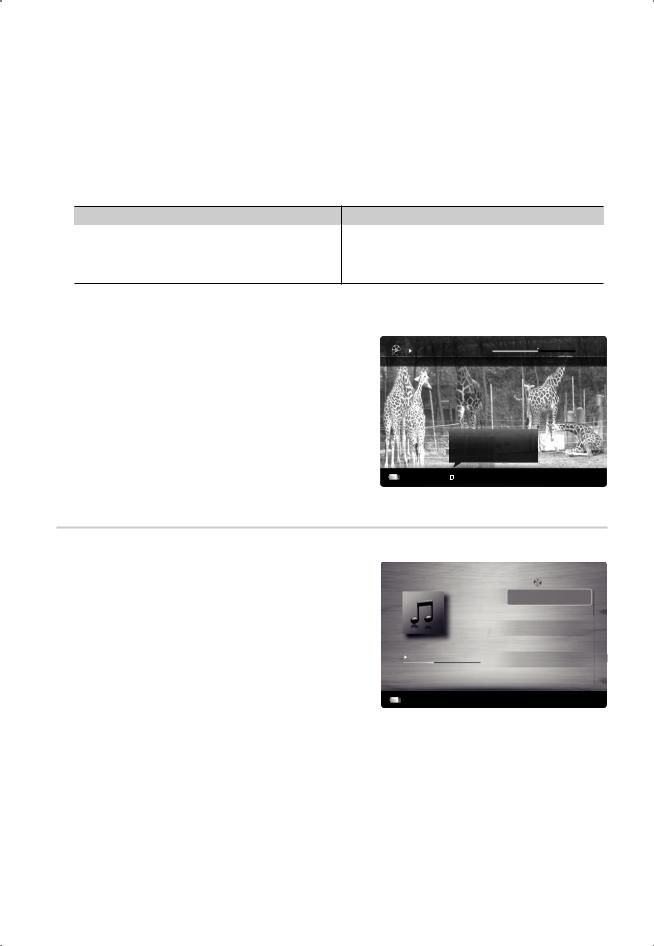
Advanced Features
Other RestrictionsNOTE
xx If there are problems with the contents of a codec, the codec will not be supported.
xx If the information for a Container is incorrect and the file is in error, the Container will not be able to play correctly.
xx Sound or video may not work if the contents have a standard bitrate/frame rate above the compatible Frame/sec listed in the table above.
xx If the Index Table is in error, the Seek (Jump) function is not supported.
|
Video Decoder |
|
Audio Decoder |
|
|
||
• Supports up to H.264, Level 4.1 |
• Supports up to WMA 7, 8, 9, STD |
||
• |
H.264 FMO / ASO / RS, VC1 SP / MP / AP L4 and AVCHD are not |
• |
WMA 9 PRO does not support 2 channel excess multi channel or |
|
supported. |
|
lossless audio. |
• |
GMC is not supported. |
• |
WMA sampling rate 22050Hz mono is not supported. |
•H.263 is not supported.
Playing movie continuously (Resume Play)
If you exit the playing movie function, the movie can be played later from the point where it was stopped.
1.Select the movie file you want to play continuously by pressing the ◄ or ► button to select it from the file list section.
2.Press the (Play) / ENTERE button.
3.Select Play Continuously (Resume Play) by pressing the Blue
button. The Movie will begin to play from where it was stopped.The Blue button is available when resuming play.
If the Continuous Movie Play Help function is set to On
in the Settings menu, a pop-up message will appear when you resume play a movie file.
00:04:03 / 00:07:38 |
1/1 |
Movie 01.avi
 Play continuously
Play continuously
Resumes playing from the last viewed scene.
SUM |
|
Play continuously E Pause L Jump T Tools R Return |
Music
Playing Music
1.Press the ◄ or ► button to select Music, then press the ENTERE button in the Media Play menu.
2.Press the ◄/►/▲/▼ button to select the desired Music file in the file list.
3.Press the ENTERE button or (Play) button.
––During music playback, you can search using the ◄ and ► button.
––(REW) and µ (FF) buttons do not function during play.
Only displays the files with MP3 and PCM file extension. Other file extensions are not displayed, even if they are saved on the same USB device.
|
Playlist |
3/15 |
I Love You |
I Love you |
|
Jhon |
Jhon |
|
1st Album |
Music 1 |
|
No Singer |
|
|
Pop |
|
|
Music 2 |
|
|
2010 |
|
|
4.2MB |
No Singer |
|
|
Music 3 |
|
|
No Singer |
|
01:10 / 04:02 |
Music 4 |
|
|
No Singer |
|
|
Music 5 |
|
|
No Singer |
|
SUM |
EPause L Jump T Tools |
R Return |
If the sound is abnormal when playing MP3 files, adjust the Equalizer in the Sound menu. (An over-modulated MP3 file may cause a sound problem.)
24 English
